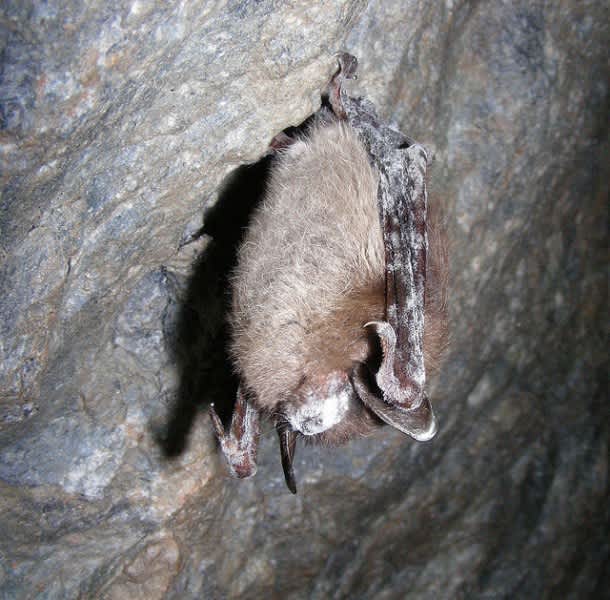First Case of White-Nose Syndrome Confirmed in Alabama Bats
OutdoorHub Reporters 03.14.12

The Russell Cave Complex in Jackson County, Alabama has closed recreational use of its wet cave for spelunking in light of the first instance of white-nose syndrome (WNS) in bats at the cave complex. This is the first recorded appearance of WNS in Alabama, to conservationists’ dismay.
“In 2009, we even kept researchers away from the cave,” said Mary Shew, the Resource Management Specialist for the National Park Service. The Alabama Department of Conservation and Natural Resources (ADCNR) has taken measures to protect the state’s wildlife and prevent spelunkers from becoming unknowing vectors of the disease, restricting access to the Russel Complex in particular.
“We’re asking that people stay out of the cave,” Shew said. The U.S. Fish and Wildlife Service and various researchers have confirmed that the spores of the fungus have been found on boots and clothes of people. “You could take those sediments and move to an unaffected area,” Shew warns. Bats can also get the fungus from other bats and from the environment.
Original press release issued by Alabama Department of Conservation and Natural Resources on March 14th, 2012:
White-nose syndrome (WNS), the disease that has killed millions of bats in eastern North America, has been confirmed in bats in the Russell Cave complex in Jackson County, marking the arrival of the disease in Alabama.
“White-nose syndrome had been confirmed in several counties in Tennessee, but had yet to be discovered in Alabama until this year,” said Keith Hudson, a biologist with the Alabama Department of Conservation and Natural Resources. “This disease is likely one of the most significant disease threats to bat populations in Alabama due to its potential to affect multiple bat species and the devastating nature of the affliction. This disease is not known to affect humans.”
Although scientists have yet to fully understand white-nose syndrome, research has demonstrated the disease is caused by a newly discovered fungus, Geomyces destructans, which often grows into white tufts on the muzzles of infected bats, giving the disease its name. White-nose syndrome was first detected in New York state in 2006 and has killed more than 5.5 million cave dwelling bats in eastern North America. Mortality rates of bats have reached almost 100 percent in multi-year infected caves. With the discovery of WNS in Alabama, a total of 17 states and four Canadian Provinces have now been confirmed with the disease. This finding in Alabama represents the southern-most occurrence of WNS in North America.
On March 1, 2012, a team of surveyors from Alabama A&M University and the National Park Service, coordinated by the Alabama Bat Working Group, were conducting a bat survey in Russell Cave in Jackson County where they saw numerous bats displaying symptomatic white patches of fungus on their skin. Two tri-colored bats and tissue samples from a Northern long-eared bat from the cave were sent to the Southeastern Cooperative Wildlife Disease Study unit at the University of Georgia for testing, which confirmed the presence of white-nose syndrome. The Russell Cave complex is a cave system that spans several miles of cave passage, including entrances on private property, and Russell Cave National Monument is managed by the National Park Service.
“The National Park Service has been working closely with state and federal agencies and has implemented protection protocols to try and limit the spread of this deadly disease,” said John Bundy, Superintendent of Russell Cave National Monument. “Although the cave system has been closed for 10 years, access to the park’s archeological site remains open.”
“We have worked closely with Alabama Department of Conservation and Natural Resources and the Alabama Bat Working Group to prepare for white-nose syndrome,” said Mike Armstrong, USFWS Regional WNS Coordinator. “Now that it is confirmed here, we will continue to work with the state and our federal partners in their research and management of the disease.”
WNS is known to be transmitted primarily from bat to bat, but fungal spores may be inadvertently carried to caves by humans on clothing and caving gear. Cave visitors are encouraged to check with landowners before entering any caves or mines, and to follow U.S. Fish and Wildlife Service decontamination protocols to reduce the risk of human assisted transport of fungal spores.
Bats are an important part of our nation’s ecosystems, and provide significant pest control services to American farmers. Insectivorous bats likely save the U.S. agricultural industry at least $3 billion dollars each year, or approximately $74 per acre for the average farmer. Alabama is home to 15 species of bats, including federally listed endangered Gray and Indiana bats.
White-nose syndrome does not pose a threat to humans, pets or livestock. Physical signs associated with WNS are a white fungus on the bat’s nose, wings, ears or tail membrane, although affected bats do not always have visible fungus. Bats afflicted with WNS often exhibit unusual behavior in winter, including clustering near hibernacula entrances. Affected bats also may leave their hibernacula during the day and may be observed flying or clinging to rocks outside or on nearby buildings. Dead or dying bats are often found on the ground near affected areas. To report unusual bat activity persons can use the Alabama Bat Working Group’s website at: http://alabamabatwg.wordpress.com/report-a-bat/.
- For more information about white-nose syndrome, visit http://www.fws.gov/whitenosesyndrome.
- For more information about bats in Alabama, visit http://www.outdooralabama.com/watchable-wildlife/what/mammals/Bats/ or http://alabamabatwg.wordpress.com/.
- For more information about Russell Cave National Monument, visit http://www.nps.gov/ruca/index.htm.

